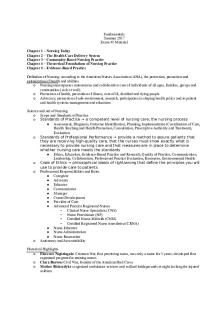Copy of homework 1 PDF

| Title | Copy of homework 1 |
|---|---|
| Author | Lula Bara |
| Course | Microbiology |
| Institution | Northeastern University |
| Pages | 4 |
| File Size | 84 KB |
| File Type | |
| Total Downloads | 66 |
| Total Views | 146 |
Summary
Homework 1 question and answers ...
Description
1. Microbes include members of which of the following groups? a) Bacteria, animals, protozoa, fungi b) Bacteria, archaea, fungi, viruses c) Archaea, viruses, plants, fungi d) Bacteria, archaea, protozoa, plants
2. W hich of the following scientist–contribution is NOT matched correctly? a) Robert Hooke–built compound microscope b) Antonie van Leeuwenhoek–discovered individual microbes c) Alexander Fleming- discovered antibiotic d) Louis Pasteur–proved spontaneous generation 3. Koch's postulates include all the following EXCEPT a) A pure culture of the pathogen must be obtained. b) The pathogen must be found in every individual suffering from the disease. c) The isolated pathogen must be used to infect healthy hosts. d) The pathogen must be shown to contain toxins. e) Healthy individuals infected with the isolated suspected pathogen must get sick with disease. 4. What does analysis of 16S rRNA sequences show? a) Plants and animals are as distant from bacteria as they are from each other. b) All microbes are distantly related to the eukaryotes. c) Archaea are as distant from bacteria as from eukaryotes. d) Viruses are closely related to prokaryotes 5. According to the three-domain model of classification, what are the ancestors of mitochondria? a) Cyanobacteria b) Fungi c) Proteobacteria d) Archaebacteria e) Protoctista
6. Which of the following scientists did NOT contribute to the discovery of the identity or structure of the genetic material ? a) Francis Crick b) Lynn Margulis c) Rosalind Franklin d) James Watson e) Frederick Griffith
7. Which of the following statements about the size of microbes is FALSE? a) Eukaryotic microbes tend to have a size of 10– 100 um. b) Prokaryotic microbes tend to have a size that is less than 10 um. c) A few bacterial species are large enough to be seen by the unaided eye. d) Choose this answer if all the above are true. 8. What is the correct order of reagents in the Gram stain? a) Iodine, crystal violet, ethanol, safranin b) Crystal violet, iodine, ethanol, safranin c) Crystal violet, ethanol, iodine, safranin d) Iodine, ethanol, safranin, crystal violet e) Safranin, ethanol, iodine, crystal violet 9. In fluorescence microscopy, the specimen absorbs incident light and then re-emits it at a _______ energy and thus, a _______ wavelength. a) lower; shorter b) lower; longer c) higher; shorter d) higher; longer
10. What is the best technique for examining the presence of a chemical structure with a diameter of 3 nm? a) Light microscopy b) Electron microscopy c) Ultracentrifugation d) Tomography e) X-ray crystallography
11. All of the following are used to lyse cells EXCEPT a) b) c) d) e)
Mild detergents Enzymes Sonication Electrophoresis Mechanical disruption
12. What is the structure in prokaryotes that performs the same function as mitochondria in eukaryotes? a) Cell membrane b) Chloroplast c) Outer membrane d) Cell wall
13. Which of the following statements about membrane lipids is true? a) b) c) d)
Lipids of bacteria have ether linkages, while those of archaea have ester linkages. Lipids of bacteria have ester linkages, while those of archaea have ether linkages. Lipids of bacteria and archaea have ester linkages. Lipids of bacteria and archaea have ether linkages.
14. Which of the following is NOT a component of peptidoglycan? a) N-acetylmuramic acid b) N-acetylglucosamine c) Lipopolysaccharide d) Amino acids e) Peptide cross-links
15. All of the following are true about the prokaryotic outer membrane EXCEPT a) It is composed of a phospholipid bilayer. b) It is found only in Gram-negative bacteria. c) It contains porins. d) It contains a toxic component. e) It contains a lipopolysaccharide layer....
Similar Free PDFs

Copy of homework 1
- 4 Pages

KINE 2356 Homework copy copy
- 3 Pages

Copy of Assignment 1
- 6 Pages

Copy of Fortinberry 1 - Review
- 45 Pages

Copy of Fundamentals Exam 1
- 31 Pages

Homework 1 EMET7001 Homework 1
- 3 Pages

Copy of Copy of Refraction SE
- 8 Pages

Copy of Copy of IWA outline
- 6 Pages

Homework 1
- 3 Pages

Homework 1
- 3 Pages

Homework 1
- 3 Pages
Popular Institutions
- Tinajero National High School - Annex
- Politeknik Caltex Riau
- Yokohama City University
- SGT University
- University of Al-Qadisiyah
- Divine Word College of Vigan
- Techniek College Rotterdam
- Universidade de Santiago
- Universiti Teknologi MARA Cawangan Johor Kampus Pasir Gudang
- Poltekkes Kemenkes Yogyakarta
- Baguio City National High School
- Colegio san marcos
- preparatoria uno
- Centro de Bachillerato Tecnológico Industrial y de Servicios No. 107
- Dalian Maritime University
- Quang Trung Secondary School
- Colegio Tecnológico en Informática
- Corporación Regional de Educación Superior
- Grupo CEDVA
- Dar Al Uloom University
- Centro de Estudios Preuniversitarios de la Universidad Nacional de Ingeniería
- 上智大学
- Aakash International School, Nuna Majara
- San Felipe Neri Catholic School
- Kang Chiao International School - New Taipei City
- Misamis Occidental National High School
- Institución Educativa Escuela Normal Juan Ladrilleros
- Kolehiyo ng Pantukan
- Batanes State College
- Instituto Continental
- Sekolah Menengah Kejuruan Kesehatan Kaltara (Tarakan)
- Colegio de La Inmaculada Concepcion - Cebu




